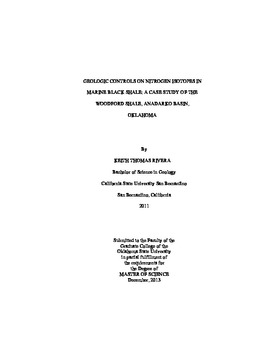| dc.contributor.advisor | Quan, Tracy M. | |
| dc.contributor.author | Rivera, Keith Thomas | |
| dc.date.accessioned | 2015-06-17T20:07:41Z | |
| dc.date.available | 2015-06-17T20:07:41Z | |
| dc.date.issued | 2013-12-01 | |
| dc.identifier.uri | https://hdl.handle.net/11244/19481 | |
| dc.description.abstract | Determining depositional environments of organic-rich black shale can enhance the identification of hydrocarbon producing intervals. Several methods have been utilized to identify depositional environments; however, for this study an isotopic approach was used. Bulk sedimentary δ15N signals have been used to identify water column redox states of sediments, but affects of thermal maturity on δ15N are unknown. Understanding the thermal maturity alterations on bulk sedimentary δ15N is relevant to identifying target intervals for ultimate hydrocarbon recovery. In attempt to understand the depositional, diagenetic, and thermal maturation affects on the bulk sedimentary δ15N signals, we sampled the Devonian-age Woodford Shale at different depths from the depocenter of the Anadarko Basin to an outcrop east of the Anadarko Shelf in the Ozark Plateau to test different thermal maturity levels. The Ro maturity levels of the Woodford Shale at the sample locations ranged from 0.56 % to 1.43 %, which cover oil generation to gas generation. The results indicate that the δ15N values of the Woodford Shale produce two different populations. One population has an average δ15N value that is 3.4 ‰ heavier than the average δ15N value of the other population. On an individual location and basin wide scale, deeper sediments are isotopically lighter than shallower sediments in terms of nitrogen, and these deeper sediments are more thermally mature. Data suggests high concentrations of redox sensitive trace metals, uranium (U) and molybdenum (Mo), are associated with the population of low bulk sedimentary δ15N values, while low concentrations of U and Mo and the presence of burrows are associated with the population of high bulk sedimentary δ15N values. The observed relationship between bulk sedimentary δ15N and Ro is opposite than that expected to be seen by nitrogen isotopes affected by thermal maturity. On the other hand, the observed relationship between bulk sedimentary δ15N and trace metal concentrations indicates that bulk sedimentary δ15N values are strongly influenced by the redox state of the water column during deposition. This relationship was observed on both an individual scale and basin wide scale, which suggests redox water column conditions changed during Woodford deposition and were locally dependent. | |
| dc.format | application/pdf | |
| dc.language | en_US | |
| dc.publisher | Oklahoma State University | |
| dc.rights | Copyright is held by the author who has granted the Oklahoma State University Library the non-exclusive right to share this material in its institutional repository. Contact Digital Library Services at lib-dls@okstate.edu or 405-744-9161 for the permission policy on the use, reproduction or distribution of this material. | |
| dc.title | Geologic Controls on Nitrogen Isotopes in Marine Black Shale: a Case Study of the Woodford Shale, Anadarko Basin, Oklahoma | |
| dc.type | text | |
| dc.contributor.committeeMember | Atekwana, Eliot Anong | |
| dc.contributor.committeeMember | Pashin, Jack | |
| osu.filename | Rivera_okstate_0664M_13012.pdf | |
| osu.accesstype | Open Access | |
| dc.description.department | Geology | |
| dc.type.genre | Thesis | |
| dc.subject.keywords | isotopes | |
| dc.subject.keywords | marine | |
| dc.subject.keywords | nitrogen | |
| dc.subject.keywords | shale | |
| dc.subject.keywords | wooford | |
